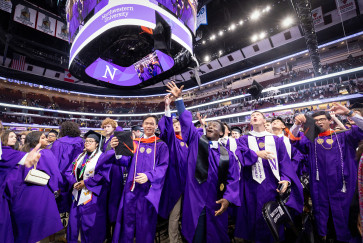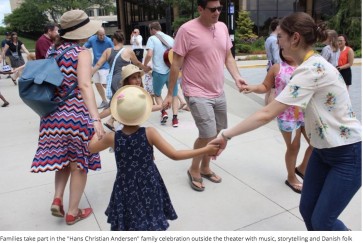SAN FRANCISCO --- An interdisciplinary group of Northwestern University undergraduates set out to learn the inner workings of tech startups through a new immersion program in San Francisco and found themselves part of the culture they emulate.
“You think of innovation in terms of incubators and accelerators, but in San Francisco, it is happening all around you, all the time,” said Samarth Soni, a sophomore from New Delhi pursuing a double major in journalism and political science. “There’s something in the air in San Francisco, and it became part of everything we did.”
Soni is one of a cross-section of students -- 11 from the McCormick School of Engineering, 11 from the Medill School of Journalism, Media, Integrated Marketing Communications and one student from the School of Education and Social Policy -- who are the first to complete the new Bay Area Immersion Experience offered in Northwestern’s new educational space in downtown San Francisco.
The latest collaboration between McCormick and Medill, the quarter-long immersion program gives students an intimate understanding of the intersection of design and media innovation.
“Medill and McCormick set out not just to teach four courses in San Francisco, but literally to immerse our students in the Bay Area’s culture -- thus the name of the program,” said Knight Professor of Digital Media Strategy Owen Youngman of Medill.

From left to right: Northwestern students Kristen Stuzynski, Birthe Ong Cheng,
Mikowai Ashwili and Louis Lu.
---
Over the winter quarter, the students took four courses together; one in communication design, which focused on developing visual and interactive design skills, one project-based course in design innovation, and two journalism courses, including one on media innovation in Silicon Valley and another titled “The Googlization of American Media.” Most of the students studied together in the fall in Evanston as part of their preparation.
They also spent a great deal of time outside the classroom.
“We eat, breathe and live a new culture, and we learn to innovate by doing,” said Liz Gerber, associate professor of design and faculty founder of Northwestern’s Design for America at McCormick. “The students witnessed designers drawing up designs, building models in the shop and testing new ideas in the field. The students then did the same.”
You think of innovation in terms of incubators and accelerators, but in San Francisco, it is happening all around you, all the time. There’s something in the air in San Francisco, and it became part of everything we did. ”
sophomore
On the 18th floor of the glinting high-rise that is home to Northwestern’s new San Francisco space, the students are almost always together.
“The space has been like a home,” said Kristen Stuzynski, a junior majoring in mechanical engineering and a New Jersey native. “We eat lunches, take breaks, play games and, while we don’t technically sleep there, sometimes you stay so late you wish you could.”
Not only are the students immersed in the startup culture of the Bay Area and Silicon Valley, they also are immersed in interdisciplinary curriculum that fuses design and journalism in a manner perfectly suited to the jobs of the future.
Stuzynski and Soni, along with a third student, Brian Saunders, were teamed up in Gerber’s design class for their final project. The team came up with an idea that incorporated design and storytelling and could help the predominantly white, male workforce of the Silicon Valley area better relate to refugees.
“Refugees are perceived to be so different than us, but they are not,” Stuzynski said. “Refugees are here to make sure their children get a good education and their families are safe.”

From left to right: Northwestern students Lu, Anna Cebulski and Cheng.
---
The group came up with a mock company called Foodiverse that caters box lunches to area startups. Inside each stackable lunchbox is the story of a refugee who has resettled in the U.S., along with menu items inspired by their native country.
The Bay Area startup culture is hungry for diverse voices.
“This is a group of people who want to understand more, but by not doing anything about it they risk being part of the problem,” Stuzynski said. “There is an opportunity to bridge a gap.”
As part of the curriculum, the students visited Northwestern alumni at leading design consultancies and tech startups.
Northwestern alumnus Andrew Prince, content strategist at Instagram, served as a project sponsor, working with the students as they developed their projects.
“I was so impressed with the quality and depth of the students’ projects,” said Prince, a 2008 graduate of Medill who also obtained a certificate in design engineering from McCormick.
“The design thinking methods these students learned are some of the most important, practical and applicable skills imaginable,” Prince said. “Thinking critically and empathetically, and learning how to iterate, do research and solve problems in teams are core skills in roles like content strategy, and they are tools these students can carry with them to every project.”
As part of one of their classes, the students also worked directly with several startups.
Soni worked for Meedan, a startup that builds digital tools for global journalism and translation. He was tasked with evaluating potential markets and developing a pricing model for a new tool called Bridge, which enables rapid translation of social media with a focus on more nuanced language that is often lost in translation.
“Meedan did a lot of important translation work during the Arab Spring when people all over the world were trying to understand what was happening through social media,” Soni said. “Working with Meedan was an eye-opening experience in terms of how startups work from a business standpoint.”
For the engineers, the immersion experience was a first foray into journalism, and for many of the journalists, the program was their first taste of design.
Soni said he is hooked.
“I discovered a passion for design I didn’t know I had,” said Soni, who is planning to pursue a Segal Design Certificate. “I might never have discovered this part of myself had I not signed up for the program.”
From their professors’ perspectives, all the students were able to tap into and hone new ways of thinking.
“By the end of the quarter, I had to look at the class list to remember who was a journalism major and who was an engineering major,” Gerber said. “They were all able to communicate effectively, build new services and work with many different people; these skills are needed to innovate, regardless of discipline.”

